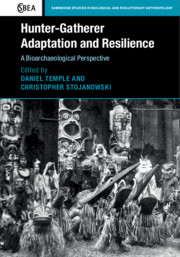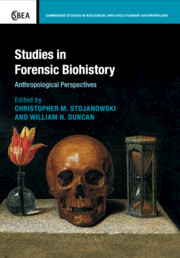20 results
Contents
-
- Book:
- Hunter-Gatherer Adaptation and Resilience
- Published online:
- 23 November 2018
- Print publication:
- 06 December 2018, pp vii-viii
-
- Chapter
- Export citation
1 - Interrogating the Alterity of Hunter-Gatherers in Bioarchaeological Context: Adaptability, Transformability, and Resilience of Hunter-Gatherers in the Past
-
-
- Book:
- Hunter-Gatherer Adaptation and Resilience
- Published online:
- 23 November 2018
- Print publication:
- 06 December 2018, pp 1-25
-
- Chapter
- Export citation
Contributors
-
- Book:
- Hunter-Gatherer Adaptation and Resilience
- Published online:
- 23 November 2018
- Print publication:
- 06 December 2018, pp ix-x
-
- Chapter
- Export citation
Index
-
- Book:
- Hunter-Gatherer Adaptation and Resilience
- Published online:
- 23 November 2018
- Print publication:
- 06 December 2018, pp 384-396
-
- Chapter
- Export citation
9 - Persistence or Pastoralism: The Challenges of Studying Hunter-Gatherer Resilience in Africa
-
-
- Book:
- Hunter-Gatherer Adaptation and Resilience
- Published online:
- 23 November 2018
- Print publication:
- 06 December 2018, pp 193-226
-
- Chapter
- Export citation
Copyright page
-
- Book:
- Hunter-Gatherer Adaptation and Resilience
- Published online:
- 23 November 2018
- Print publication:
- 06 December 2018, pp vi-vi
-
- Chapter
- Export citation

Hunter-Gatherer Adaptation and Resilience
- A Bioarchaeological Perspective
-
- Published online:
- 23 November 2018
- Print publication:
- 06 December 2018

Studies in Forensic Biohistory
- Anthropological Perspectives
-
- Published online:
- 26 January 2017
- Print publication:
- 05 January 2017
14 - Theoretical Facets of Biohistorical Research
-
-
- Book:
- Studies in Forensic Biohistory
- Published online:
- 26 January 2017
- Print publication:
- 05 January 2017, pp 315-327
-
- Chapter
- Export citation
Contributors
-
- Book:
- Studies in Forensic Biohistory
- Published online:
- 26 January 2017
- Print publication:
- 05 January 2017, pp x-xi
-
- Chapter
- Export citation
1 - Defining an Anthropological Biohistorical Research Agenda: The History, Scale, and Scope of an Emerging Discipline
-
-
- Book:
- Studies in Forensic Biohistory
- Published online:
- 26 January 2017
- Print publication:
- 05 January 2017, pp 1-28
-
- Chapter
- Export citation
Acknowledgments
-
- Book:
- Studies in Forensic Biohistory
- Published online:
- 26 January 2017
- Print publication:
- 05 January 2017, pp xii-xii
-
- Chapter
- Export citation
Copyright page
-
- Book:
- Studies in Forensic Biohistory
- Published online:
- 26 January 2017
- Print publication:
- 05 January 2017, pp vi-vi
-
- Chapter
- Export citation
Index
-
- Book:
- Studies in Forensic Biohistory
- Published online:
- 26 January 2017
- Print publication:
- 05 January 2017, pp 328-338
-
- Chapter
- Export citation
Contents
-
- Book:
- Studies in Forensic Biohistory
- Published online:
- 26 January 2017
- Print publication:
- 05 January 2017, pp vii-ix
-
- Chapter
- Export citation
Contributors
-
-
- Book:
- Bioarchaeological and Forensic Perspectives on Violence
- Published online:
- 05 March 2014
- Print publication:
- 13 March 2014, pp x-xii
-
- Chapter
- Export citation
10 - Why some bodies matter: defacement and narrative in historical forensics cases
- from Part III - Ritual and performative violence
-
-
- Book:
- Bioarchaeological and Forensic Perspectives on Violence
- Published online:
- 05 March 2014
- Print publication:
- 13 March 2014, pp 148-168
-
- Chapter
- Export citation
Contributors
-
-
- Book:
- Anthropological Perspectives on Tooth Morphology
- Published online:
- 05 March 2013
- Print publication:
- 21 February 2013, pp viii-xi
-
- Chapter
- Export citation
17 - Sinodonty and beyond:
-
-
- Book:
- Anthropological Perspectives on Tooth Morphology
- Published online:
- 05 March 2013
- Print publication:
- 21 February 2013, pp 408-452
-
- Chapter
- Export citation
A Reassessment of Matrilocality in Chacoan Culture
-
- Journal:
- American Antiquity / Volume 67 / Issue 2 / April 2002
- Published online by Cambridge University Press:
- 20 January 2017, pp. 343-356
- Print publication:
- April 2002
-
- Article
- Export citation



